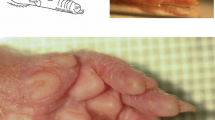Summary
Knowledge of the mechanisms of cutaneous sensation at present depends on 3 lines of evidence a) psycho-physical b) electrophysiological data from animals and c) histological studies of man and animals. Two major problems have arisen; a) the significance of the apparent histological differences between hairy and nonhairy or glabrous skin, b) do the peripheral afferent fibres differentiate between mechanical, thermal and chemical stimuli to a degree sufficient to justify a classification as mechanoreceptors and themoreceptors? Experimental electrophysiological results using afferent fibres dissected from forearm nerves of monkeys are described. Both hairy and glabrous skin gave basically similar types of responses in myelinated afferent fibres to cutaneous stimulation, except that the thresholds were in general higher for nerves ending in glabrous skin. The data are convincingly in favour of the idea that there are substantial differences in specificity of the nerve endings.
Zusammenfassung
Die Kenntnis über die Funktion der Haut als Sinnesorgan ist das Ergebnis von 3 Untersuchungsrichtungen: a) Psycho-physikalische Untersuchung, b) elektrophysiologische Untersuchung bei Tieren, c) histologische Untersuchungen bei Mensch und Tier.
2 Hauptprobleme wurden aufgeworfen:
-
1.
Die Auffälligkeiten der histologischen Unterschiede zwischen behaarter und nicht behaarter Haut,
-
2.
die Frage, ob die peripheren afferenten Fasern zwischen mechanischen, thermischen und chemischen Reizen in genügendem Ausmaß unterscheiden können, so daß ihre Klassifikation in Mechano- und Thermoreceptoren gerechtfertigt ist.
Ergebnisse elektro-physiologischer Versuche an afferenten Fasern am Unterarm des Affen werden beschrieben. Sowohl die behaarte als auch die unbehaarte Haut ergaben grundsätzlich ähnliche Arten von Antworten der afferenten myelinisierten Nerven nach Hautreizen. Lediglich die Reizschwelle war in den Nervenendigungen der unbehaarten Haut im allgemeinen höher. Die Ergebnisse sprechen eindeutig für die Ansicht, daß es wirkliche Unterschiede hinsichtlich der Spezifität von Nervenendigungen gibt.
Résumé
La connaissance des mécanismes de la sensation cutanée dépend, à présent, de trois lignes d'évidence: a) de dates psycho-physiques, b) de dates électrophysiologiques d'animaux et c) d'études histologiques de l'homme et des animaux. Il y a deux problèmes: a) la signification des différences histologiques apparentes afférentes périphériques différencient entre des stimuli mécaniques, thermiques entre la peau poilue et la peau non-poilue ou glabre, b) la question si les fibres et chimiques d'un degré qui suffit pour justifier leur classification comme des mécanorécepteurs et des thermorécepteurs. On a décrit des résultats électrophysiologiques expérimentaux en faisant usage de fibres afférentes prises de nerfs des avant-bras de singes. La peau poilue et la peau glabre ont montré des types au fond semblables de réponses dans des fibres afférentes myéliniques à une stimulation cutanée, à l'exception des cas où les seuils étaient, en général, plus hauts pour des nerfs terminant dans la peau glabre. Les dates sont, de manière convaincante, en faveur de l'idée qu'il y a des différences substantielles en ce qui concerne la spécificité des bouts nerveux.
Similar content being viewed by others
References
Adrian, E. D., The basis of sensation. Christopher (Publishers) Ltd., London, 1928.
Adrian, E. D., andY. Zotterman, J. Physiol.61 (1926), 151 and 465.
Blix, M., Zschr. J. Biol.20 (1884), 141.
Cauna, N., Anat. Rec., Philadelphia,119 (1954), 449.
Dodt, E., andY. Zotterman, Acta physiol. Scand.26 (1952), 358.
Douglas, W. W., andJ. M. Ritchie, J. Physiol.138 (1957), 19 and 31.
Douglas, W. W., J. M. Ritchie andR. W. Straub, J. Physiol.150 (1960), 266.
Fjälibrant, N., andA. Iggo, J. Physiol.156 (1961), 578.
Frankenhäuser, B., Acta physiol. Scand.18 (1949), 68.
Frey, M. v., Ber. Sächs. Ges. (Akad.) Wiss.47 (1895), 166.
Gasser, H. S., Res. Publ. Ass. Nerv. Ment. Dis., N. Y.,23 (1943), 44.
Hagen, E., H. Knoche, D. C. Sinclair andG. Weddell, Proc. Roy. Soc., London, Biol. Sc.141 (1953), 279.
Hursh, J. B., Amer. J. Physiol.127 (1939), 131.
Hensel, H., andK. Boman, This Symposium (1961).
Hensel, H., A. Iggo andI. Witt, J. Physiol.153 (1960), 113.
Hunt, C. C., andA. K. McIntyre, J. Physiol.153 (1960), 88.
Iggo, A., J. Physiol.142 (1958), 110.
Iggo, A., Quart. J. Exper. Physiol., London,44 (1959), 362.
Iggo, A., J. Physiol.152 (1960), 337.
Iggo, A., Proc. Roy. Physiol. Soc. Ed.1961 a (in the press).
Iggo, A., This Symposium (1961 b).
Iggo, A., In preparation for publication (1961 c).
Iriuchijima, J., andY. Zotterman, Acta physiol. Scand.49 (1960), 267.
Iriuchijima, J., andY. Zotterman, Acta physiol. Scand.51 (1961), 283.
Landau, W., andG. H. Bishop, Arch. Neurol. Psychiatr., Chicago,69 (1953), 490.
Lele, P. P., andG. Weddell, Exper. Neurol.1 (1960), 334.
Loewenstein, This Symposium (1961).
Maruhashi, J., K. Mizuguchi andI. Tasaki, J. Physiol.117 (1952), 129.
Montagna, W., Cutaneous Innervation. Pergamon Press, London, 1960.
Witt, I., andH. Hensel, Pflügers Arch. Physiol.268 (1959), 582.
Zotterman, Y., J. Physiol.95 (1939), 1.
Author information
Authors and Affiliations
Additional information
With 13 Figures
Rights and permissions
About this article
Cite this article
Iggo, A. An electrophysiological analysis of afferent fibres in primate skin. Acta Neurovegetativa 24, 225–240 (1962). https://doi.org/10.1007/BF01232999
Issue Date:
DOI: https://doi.org/10.1007/BF01232999




